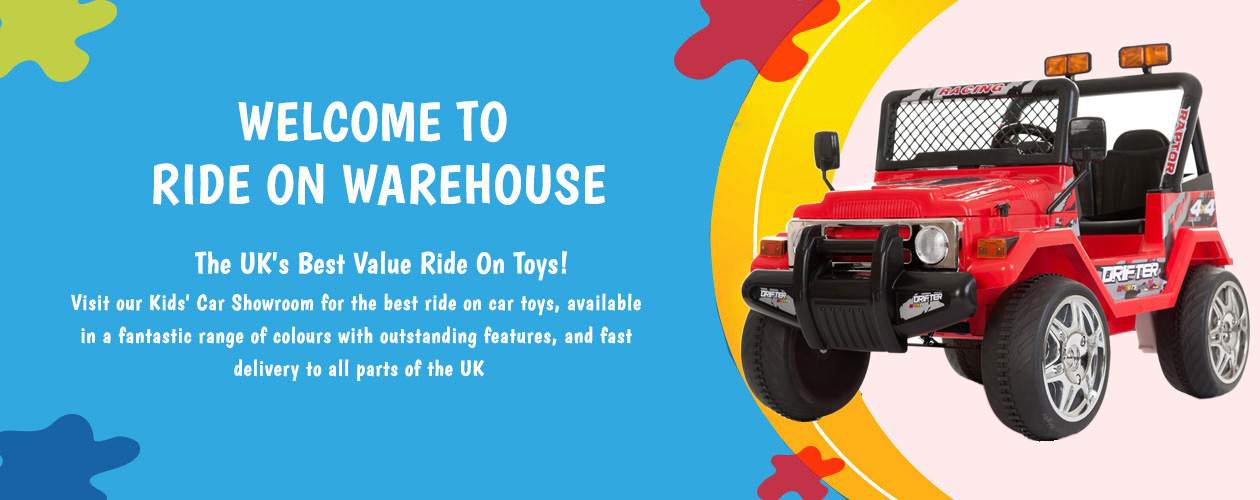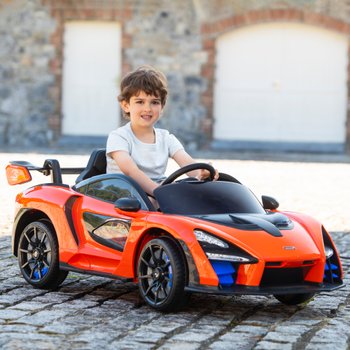Understanding the battery and charging times of an electric kids' ride-on vehicle is crucial for ensuring maximum performance and uninterrupted time for play. Here's what you should know about the battery type -
Most electric ride-on cars for kids utilize rechargeable batteries, typically lithium-ion or lead-acid batteries. Lithium ion batteries have a higher battery life than lead-acid and charge faster.
Capacity of Battery
The operating duration of the ride-on vehicle is dependent on the battery's capacity. This is measured in amp-hours or Watt-hours. Batteries with higher capacity provide more playtime before needing to recharge.
Run Time -
The run time is the longest duration of continuous operation an electric ride on car can run on one charge. It is based on a variety of factors that include the battery, the motor as well as the terrain and the weight or the rider.
For electric ride on cars typically, the run time is 30 minutes up to 2 hours from a single battery charge. Certain batteries with a higher capacity may provide more time for running.
Time for Charging -
The charging time is the length of time required for batteries to be fully recharged after it has been depleted. Charge times vary based on the battery's capacity, charger specs and charging methods.
In general the charging time for an electric ride-on vehicle is between 8 to 12 hours. Certain models provide faster charging and charging times, particularly models that utilize lithium-ion batteries.
Follow the charging guidelines that are provided by the manufacturer in order to ensure safety of the battery and longevity. Battery performance and longevity may be affected by charging too much or undercharging.
Charge Method -
Chargers for electric ride-ons are typically plugged into standard household outlets. Some models may offer quick charging or even a smart charger that monitors the battery's status of charge and adjusts charging rates accordingly.
To prevent any damage to the electrical system or battery Make sure the charger and port are compatible with chargers supplied in your ride-on car.
Batteries Additional
Certain electric ride-on vehicles might permit you to purchase additional batteries or spares to extend your playing time. Having extra batteries on hand allows you to switch out batteries that are depleted for fully charged ones, which reduces interruptions between play sessions.
When you know the charging times and the battery life of an electric vehicle for children you will be able to enjoy endless playtime and adventures. Regularly charging the battery and observing appropriate charging guidelines will maximize battery life and performance. See the top rated Audi kids car for site tips including a toy car, toy car, two seater electric cars, childs ride on car, race car toy car, remote control childrens car, car for toy, car toy car toy, toy with car, electric car ride and more. .

What Are The Best Models For Kids Cars? Designed For Indoor And Outdoor Use?
The features of the models designed for outdoor and indoor use are different. The indoor Use Cars are different.
Dimensions and Weight - Cars designed for indoor use tend to be lighter and smaller in size to move easily in tight areas like living rooms, playrooms or hallways. These vehicles are compact and compact, which allows them to maneuver easily through narrow spaces or around corners.
Low Ground Coverage - Vehicles that are designed for indoor use have an extremely low ground coverage to avoid them getting stuck or caught against obstacles like carpets and thresholds. This allows for smooth and uninterrupted mobility across indoor surfaces.
Smooth Wheels. The wheels used in indoor use cars are constructed from materials such as rubber, plastic, or laminate to give them grip. They are made to reduce noise and stop scratching or scuffing surfaces in indoor environments.
Limited Speed - Indoor vehicles generally have a limit on speed, to allow for safe and controlled driving even in tight spaces. This prevents accidents and collisions with walls, furniture, or other obstacles commonly encountered in indoor areas.
Outdoor Use Cars -
Built to Last - Vehicles that are designed for outdoor use are built with tough materials like strong plastic or steel to stand up to harsh handling and outdoor elements like sunlight, humidity, and temperature fluctuations. They are less susceptible to wear and tear caused by exposure to the elements.
Increased Ground Clearance: Outdoor-use vehicles have a higher level of ground clearance to navigate bumps and uneven terrain when driving outdoors. This allows the car to move over rough surfaces without causing damage or getting stuck.
Traction tires - Tires for outdoor vehicles usually come with treads and patterns that offer more grip and traction on slippery or uneven surfaces. This provides stability and control when driving on rough terrain, preventing skidding or sliding.
Weather Resistance - Designed for outdoor use, cars may have components that are impervious to moisture or environmental damage including waterproof casings and sealed electronics. The car is able to be exposed to mud, rain, and puddles without loss of performance.
Higher Speeds - Cars for outdoor use usually have more top speeds to accommodate wide spaces and the long distances outdoors. It provides an exhilarating and thrilling experience for kids who wish to experience the outdoors.
These characteristics and design elements will assist parents in choosing the best car for their children to meet their requirements for use and their environment. Have a look at the top rated go here on Mercedes ride on car for website recommendations including childrens electric cars, riding digger, childs electric ride on car, childs ride on car, childs electric ride on car, lambo toy car, toy toy cars, digger ride, 2 seater electric cars, toy car and more. .

How Do You Determine An Appropriate Budget For Your Ride-On Kid's Car Purchase?
When you are deciding on your budget, it is important to take into consideration features, durability, and your financial position. You can find the best price and budget by researching average prices.
It is a good idea to start by researching the average price of the children's ride-on vehicles that have the features you desire. Pricing information can be found on the websites of the manufacturers and online toy stores as well as retailers.
Find out the features you need -
Consider the features that are essential to your child's safety and enjoyment. Ride-on cars with features like realistic sounds, belts for seats, remote controls and functional headlights could be more expensive.
Prioritize features in accordance with the preferences of your child as well with your budget.
Think about Durability and Length of Life
Seek out ride-on vehicles constructed with durable materials, such as metals and plastics of high-end quality that are able to withstand daily usage and weather conditions.
For a better idea of the endurance and long-term durability, you can read reviews or seek out suggestions from other parents. By investing more upfront into a ride-on solidly constructed, you will be able to avoid frequent repairs and replacements.
Compare prices from various retailers
Shop around and compare prices of different retailers to discover the best value for your budget. Compare prices and special deals on department stores, online retailers and even specialty shops.
Look out for clearance and discount sales that can help you save money without the quality.
Include extra costs in your budget -
Be aware of any additional costs that come with purchasing a car for kids that is ride-on for example, shipping charges and taxes or other accessories (e.g., spare batteries, safety equipment).
Budget your total costs of ownership including accessories and maintenance to make sure you can pay for them.
Establish a Budget That Is real
A budget that is realistic should be set according to your requirements, priorities and the findings of your study. Determine the maximum amount you're willing to invest in a ride-on car while considering the quality of features, durability, as well as longevity.
Don't spend too much or overspread your budget to add unnecessary features in your child's play.
Be aware of the long-term value
Consider the long-term worth of the ride-on kid's car by looking at its longevity, versatility, and ability to adapt alongside your child. It may be worth investing into a larger model with more features over the long run.
If you set a reasonable budget and carefully compare the features, durability and value over the long term of each ride-on child's car You will discover that it's worth every penny. Prioritize the features that are most important to your child's happiness and safety, while remaining within your budget constraints. Follow the top rated ride on toys kidscars.co.uk advice for more advice including toy ride, race car toy car, toy a car, remote control childrens car, ride electric car, two seater childrens electric cars, car toy car toy, childs electric ride on car, electric car ride, electric ride on cars and more. .
